Predicting Ocean Temperature in High-Frequency Internal Wave Area with Physics-Guided Deep Learning: A Case Study from the South China Sea
Abstract
:1. Introduction
- We propose a physics-guided spatio-temporal network to predict ocean temperature in the South China Sea. The results show higher accuracy than the traditional model.
- The physical loss of the model is the primary focus and is proven to be effective, and integrating with physical knowledge is beneficial for improving data utilization.
- We use a multiple-parallel-input and multi-step-output scheme, which makes the input data become a sequence of matrices from several depths and captures the spatial relative changes in ocean temperature at different depths well.
- We use pretraining, which can enhance the effectiveness of model learning under the condition of scarce measured data.
2. Materials and Methods
2.1. Datasets
2.2. Physics-Guided Spatio-Temporal Convolutional Neural Network
2.2.1. PGSTCN
2.2.2. Interpolation
2.2.3. Parallel Input and Multi-Step Output
2.2.4. Loss Function
2.2.5. Pretraining
3. Experiments and Results
3.1. Environment Setup
3.2. Baseline and Evaluation Metrics
- LSTM: Long short-term memory (LSTM) is a variation of a recurrent neural network (RNN) which introduces a “gates” mechanism to control information maintenance and forgetting. LSTM is widely used in sequence processing such as text, speech, and general time series.
- ConvLSTM: Convolutional LSTM network (ConvLSTM) is a variation of LSTM for precipitation nowcasting that transfers the fully connected operations in both the input-to-state and state-to-state transitions to convolutional structures. It can efficiently extract spatial features without too much redundant information and applies them to spatially determined phenomena forecasting such as the weather, movies, and traffic flow.
- Root mean square error (RMSE): This is used to measure the deviation of computed values from observed ones.
- Accuracy: This reflects how close the prediction is to an actual observation value.
- Physical inconsistency: We counted the proportion of temperature differences between the upper and lower depths of the test datasets that did not satisfy the assumption of physical consistency (, supposing that the vertical distribution of temperature over a depth satisfies monotonicity). The mathematical expression is as follows:
3.3. Results
3.3.1. One-Step Prediction
3.3.2. Multi-Step Prediction
3.3.3. Data Volume Change Analysis
3.3.4. PIMO Analysis
4. Discussion
5. Conclusions
Author Contributions
Funding
Informed Consent Statement
Data Availability Statement
Acknowledgments
Conflicts of Interest
References
- Kug, J.S.; Kang, I.S.; Lee, J.Y.; Jhun, J.G. A statistical approach to Indian Ocean sea surface temperature prediction using a dynamical ENSO prediction. Geophys. Res. Lett. 2004, 31, L09212. [Google Scholar] [CrossRef]
- Aguilar-Martinez, S.; Hsieh, W.W. Forecasts of tropical Pacific sea surface temperatures by neural networks and support vector regression. Int. J. Oceanogr. 2009, 2009, 167239. [Google Scholar] [CrossRef]
- Zhang, Q.; Wang, H.; Dong, J.; Zhong, G.; Sun, X. Prediction of Sea Surface Temperature Using Long Short-Term Memory. IEEE Geosci. Remote Sens. Lett. 2017, 14, 1745–1749. [Google Scholar] [CrossRef]
- Schultz, J.; Aikman, F. Sea surface temperature evaluation of the Coastal Ocean Forecast System. In Proceedings of the OCEANS 96 MTS/IEEE Conference Proceedings. The Coastal Ocean—Prospects for the 21st Century, Fort Lauderdale, FL, USA, 23–26 September 1996; Volume 1, pp. 245–250. [Google Scholar] [CrossRef]
- Meng, X.; Cheng, J. Estimating land and sea surface temperature from cross-calibrated Chinese Gaofen-5 thermal infrared data using split-window algorithm. IEEE Geosci. Remote Sens. Lett. 2019, 17, 509–513. [Google Scholar] [CrossRef]
- Tandeo, P.; Autret, E.; Piolle, J.F.; Tournadre, J.; Ailliot, P. A Multivariate Regression Approach to Adjust AATSR Sea Surface Temperature to In Situ Measurements. IEEE Geosci. Remote Sens. Lett. 2009, 6, 8–12. [Google Scholar] [CrossRef]
- Mahongo, S.B.; Deo, M.C. Using Artificial Neural Networks to Forecast Monthly and Seasonal Sea Surface Temperature Anomalies in the Western Indian Ocean. Int. J. Ocean Clim. Syst. 2013, 4, 133–150. [Google Scholar] [CrossRef]
- Xiao, C.; Chen, N.; Hu, C.; Wang, K.; Xu, Z.; Cai, Y.; Xu, L.; Chen, Z.; Gong, J. A spatiotemporal deep learning model for sea surface temperature field prediction using time-series satellite data. Environ. Model. Softw. 2019, 120, 104502. [Google Scholar] [CrossRef]
- Xu, L.; Li, Q.; Yu, J.; Wang, L.; Xie, J.; Shi, S. Spatio-temporal predictions of SST time series in China’s offshore waters using a regional convolution long short-term memory (RC-LSTM) network. Int. J. Remote Sens. 2020, 41, 3368–3389. [Google Scholar] [CrossRef]
- Song, T.; Wang, Z.; Xie, P.; Han, N.; Jiang, J.; Xu, D. A novel dual path gated recurrent unit model for sea surface salinity prediction. J. Atmos. Ocean. Technol. 2020, 37, 317–325. [Google Scholar] [CrossRef]
- Li, Q.J.; Zhao, Y.; Liao, H.L.; Li, J.K. Effective forecast of Northeast Pacific sea surface temperature based on a complementary ensemble empirical mode decomposition–support vector machine method. Atmos. Ocean. Sci. Lett. 2017, 10, 261–267. [Google Scholar] [CrossRef]
- Patil, K.; Deo, M.; Ravichandran, M. Prediction of sea surface temperature by combining numerical and neural techniques. J. Atmos. Ocean. Technol. 2016, 33, 1715–1726. [Google Scholar] [CrossRef]
- Fischer, C.C.; Tibbetts, K.J.; Morgan, D.; Ceder, G. Predicting crystal structure by merging data mining with quantum mechanics. Nat. Mater. 2006, 5, 641–646. [Google Scholar] [CrossRef]
- Karpatne, A.; Watkins, W.; Read, J.; Kumar, V. Physics-guided neural networks (pgnn): An application in lake temperature modeling. arXiv 2017, arXiv:1710.11431. [Google Scholar]
- Daw, A.; Thomas, R.Q.; Carey, C.C.; Read, J.S.; Appling, A.P.; Karpatne, A. Physics-guided architecture (pga) of neural networks for quantifying uncertainty in lake temperature modeling. In Proceedings of the 2020 Siam International Conference on Data Mining, SIAM 2020, Cincinnati, OH, USA, 7–9 May 2020; pp. 532–540. [Google Scholar]
- Jia, X.; Willard, J.; Karpatne, A.; Read, J.S.; Zwart, J.A.; Steinbach, M.; Kumar, V. Physics-guided machine learning for scientific discovery: An application in simulating lake temperature profiles. ACM/IMS Trans. Data Sci. 2021, 2, 1–26. [Google Scholar] [CrossRef]
- Von Rueden, L.; Mayer, S.; Beckh, K.; Georgiev, B.; Giesselbach, S.; Heese, R.; Kirsch, B.; Pfrommer, J.; Pick, A.; Ramamurthy, R.; et al. Informed Machine Learning—A taxonomy and survey of integrating prior knowledge into learning systems. IEEE Trans. Knowl. Data Eng. 2021, 35, 614–633. [Google Scholar] [CrossRef]
- Jiang, C.M.; Kashinath, K.; Prabhat; Marcus, P. Enforcing Physical Constraints in CNNs through Differentiable PDE Layer. In Proceedings of the ICLR 2020 Workshop on Integration of Deep Neural Models and Differential Equations, Addis Ababa, Ethiopia, 23 December 2019. [Google Scholar]
- Wu, D.; Gao, L.; Xiong, X.; Chinazzi, M.; Vespignani, A.; Ma, Y.A.; Yu, R. DeepGLEAM: A hybrid mechanistic and deep learning model for COVID-19 forecasting. arXiv 2021, arXiv:2102.06684. [Google Scholar]
- Wu, S.; Li, X.; Dong, W.; Wang, S.; Zhang, X.; Xu, Z. Multi-source and heterogeneous marine hydrometeorology spatio-temporal data analysis with machine learning: A survey. World Wide Web 2023, 26, 1115–1156. [Google Scholar] [CrossRef]
- Grimshaw, R.; Guo, C.; Helfrich, K.; Vlasenko, V. Combined Effect of Rotation and Topography on Shoaling Oceanic Internal Solitary Waves. J. Phys. Oceanogr. 2014, 44, 1116–1132. [Google Scholar] [CrossRef]
- Gong, Y.; Xie, J.; Xu, J.; Chen, Z.; He, Y.; Cai, S. Oceanic internal solitary waves at the Indonesian submarine wreckage site. Acta Oceanol. Sin. 2022, 41, 109–113. [Google Scholar] [CrossRef]
- Zhang, X.; Huang, X.; Zhang, Z.; Zhou, C.; Tian, J.; Zhao, W. Polarity Variations of Internal Solitary Waves over the Continental Shelf of the Northern South China Sea: Impacts of Seasonal Stratification, Mesoscale Eddies, and Internal Tides. J. Phys. Oceanogr. 2018, 48, 1349–1365. [Google Scholar] [CrossRef]
- Wu, S.; Zhang, X.; Dong, W.; Wang, S.; Li, X.; Bao, S.; Li, K. Physics-Based Spatio-Temporal Modeling With Machine Learning for the Prediction of Oceanic Internal Waves. In Proceedings of the 2022 IEEE Smartworld, Ubiquitous Intelligence & Computing, Scalable Computing & Communications, Digital Twin, Privacy Computing, Metaverse, Autonomous & Trusted Vehicles (SmartWorld/UIC/ScalCom/DigitalTwin/PriComp/Meta), Haikou, China, 15–18 December 2022; pp. 604–609. [Google Scholar] [CrossRef]
- Zhou, C.; Zhao, W.; Tian, J.; Yang, Q.; Qu, T. Variability of the deep-water overflow in the Luzon Strait. J. Phys. Oceanogr. 2014, 44, 2972–2986. [Google Scholar] [CrossRef]
- Huang, X.; Zhang, Z.; Zhang, X.; Qian, H.; Zhao, W.; Tian, J. Impacts of a Mesoscale Eddy Pair on Internal Solitary Waves in the Northern South China Sea revealed by Mooring Array Observations. J. Phys. Oceanogr. 2017, 47, 1539–1554. [Google Scholar] [CrossRef]
- Alford, M.H. The formation and fate of internal waves in the South China Sea. Nature 2015, 521, 65–69. [Google Scholar] [CrossRef]
- Rice, J.; Xu, W.; August, A. Analyzing Koopman approaches to physics-informed machine learning for long-term sea-surface temperature forecasting. arXiv 2020, arXiv:2010.00399. [Google Scholar]
- Karniadakis, G.E.; Kevrekidis, I.G.; Lu, L.; Perdikaris, P.; Wang, S.; Yang, L. Physics-informed machine learning. Nat. Rev. Phys. 2021, 3, 422–440. [Google Scholar] [CrossRef]
- Willard, J.; Jia, X.; Xu, S.; Steinbach, M.; Kumar, V. Integrating Physics-Based Modeling with Machine Learning: A Survey. arXiv 2020, arXiv:2003.04919. [Google Scholar]
- Kashinath, K.; Mustafa, M.; Albert, A.; Wu, J.L.; Prabhat. Physics-informed machine learning: Case studies for weather and climate modelling. Philos. Trans. R. Soc. Math. Phys. Eng. Sci. 2021, 379, 20200093. [Google Scholar] [CrossRef]



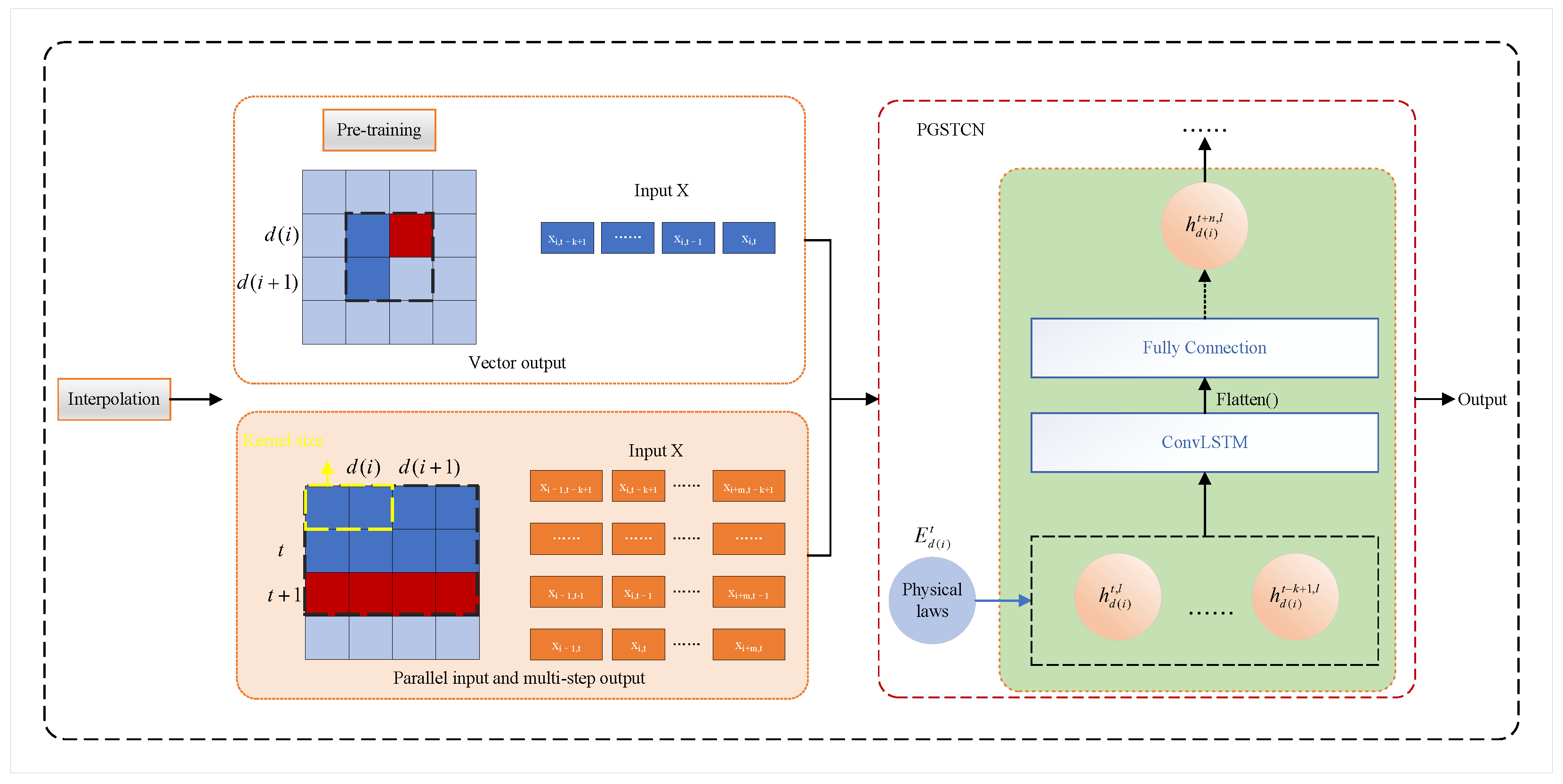

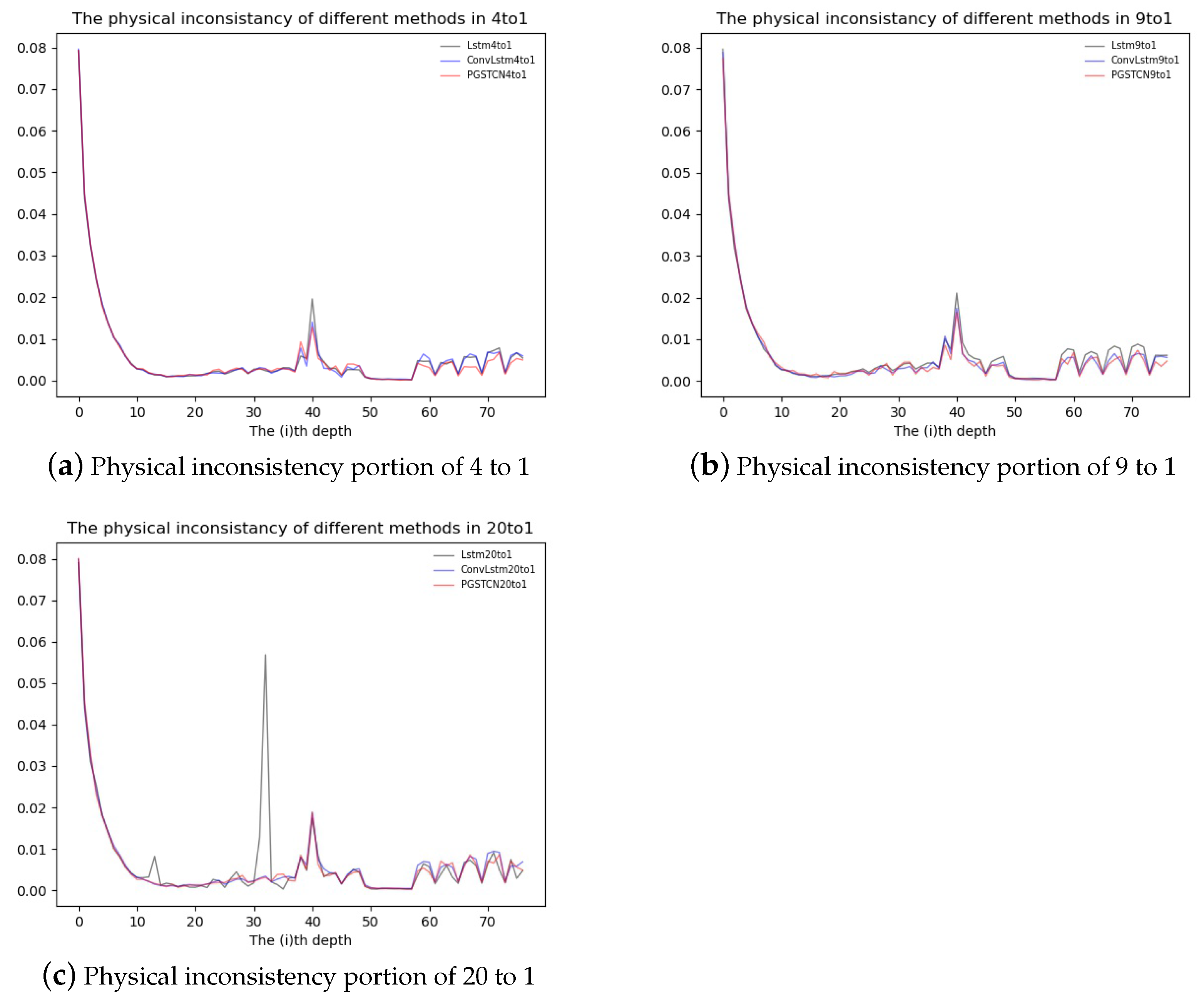
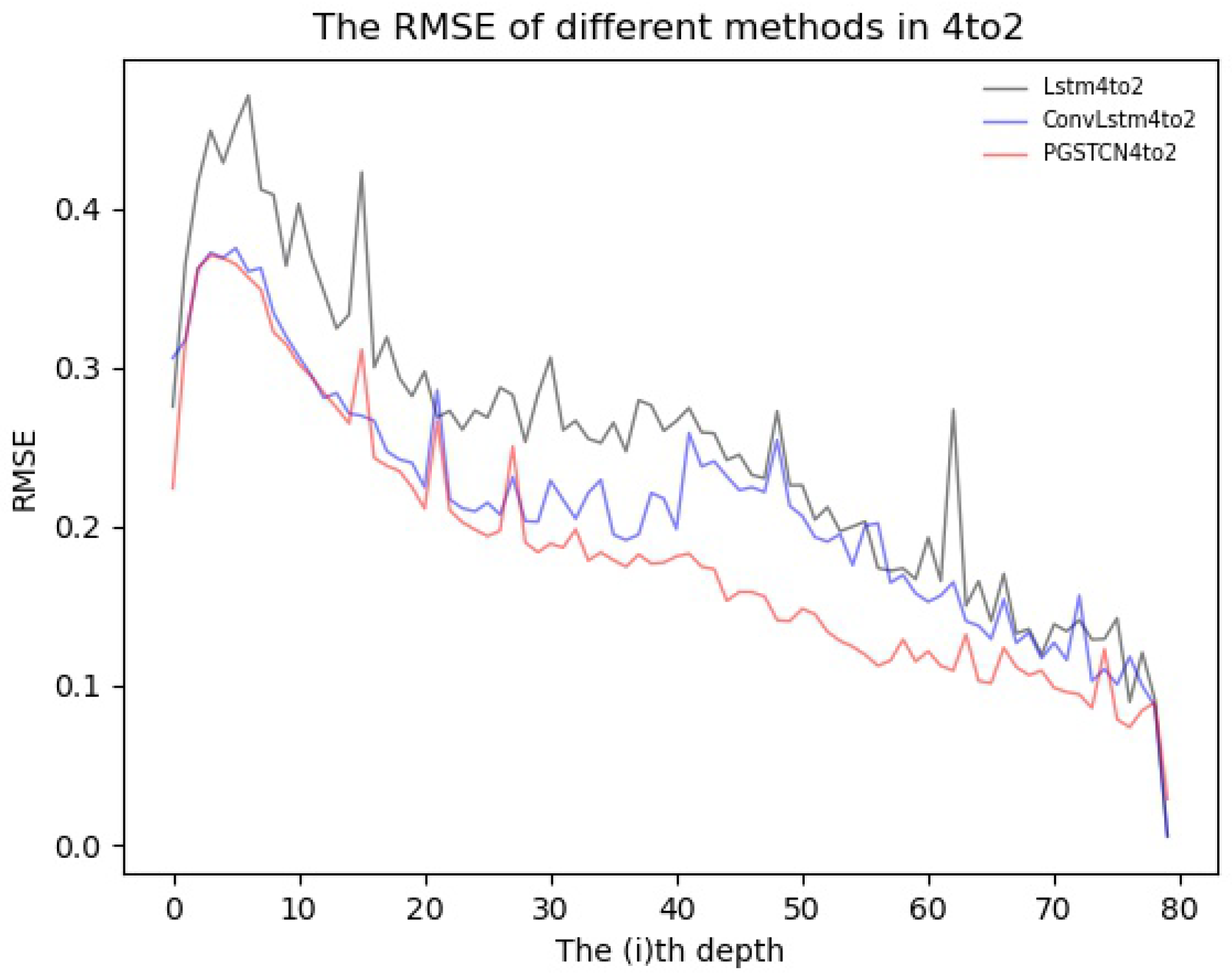

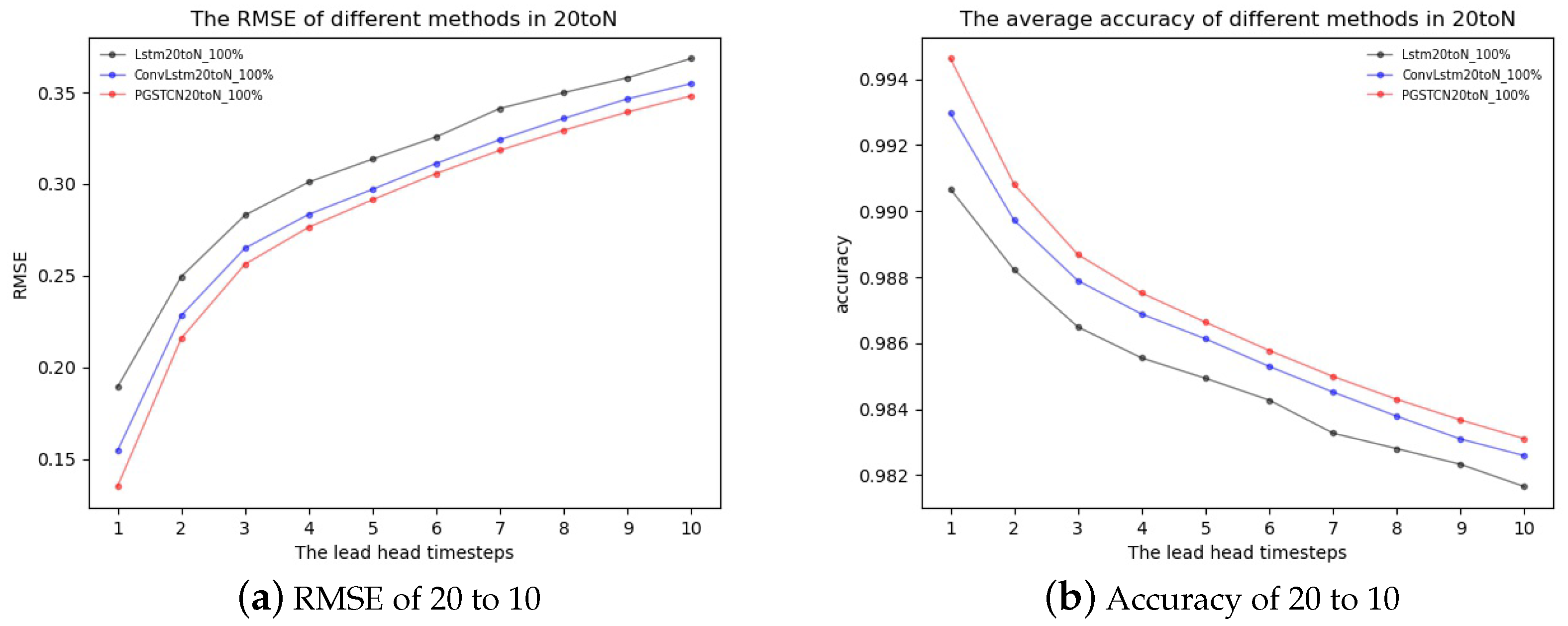
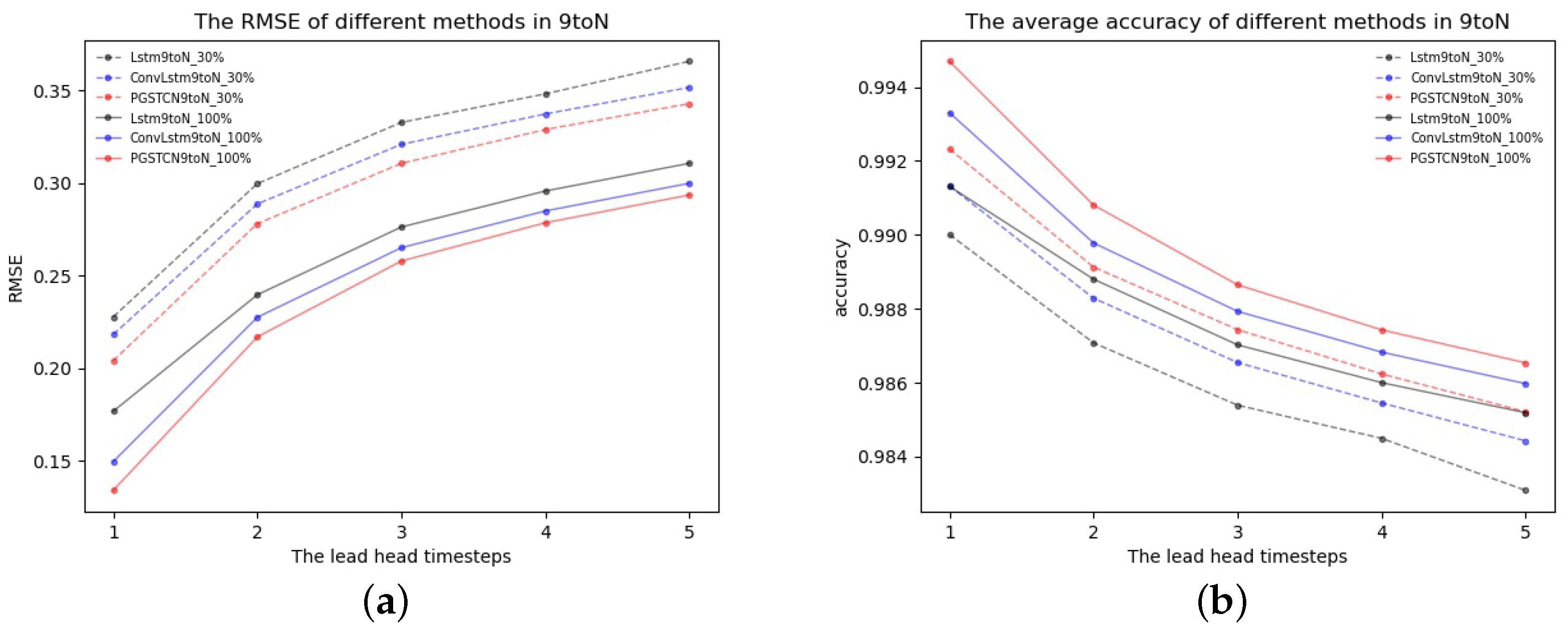


| Longitude, Latitude | Instrument (Looking) | Instrument Depth (m) | Range Depth (m) | Observation Period | Sample Interval (min) |
|---|---|---|---|---|---|
| 117°26′, 21°16′ | Temperature chains | 85–475 | 85–475 | 2014.06.05 to 2015.06.09 | 3 |
| ADCP (up) | 485 | 60–460 |
Disclaimer/Publisher’s Note: The statements, opinions and data contained in all publications are solely those of the individual author(s) and contributor(s) and not of MDPI and/or the editor(s). MDPI and/or the editor(s) disclaim responsibility for any injury to people or property resulting from any ideas, methods, instructions or products referred to in the content. |
© 2023 by the authors. Licensee MDPI, Basel, Switzerland. This article is an open access article distributed under the terms and conditions of the Creative Commons Attribution (CC BY) license (https://creativecommons.org/licenses/by/4.0/).
Share and Cite
Wu, S.; Zhang, X.; Bao, S.; Dong, W.; Wang, S.; Li, X. Predicting Ocean Temperature in High-Frequency Internal Wave Area with Physics-Guided Deep Learning: A Case Study from the South China Sea. J. Mar. Sci. Eng. 2023, 11, 1728. https://doi.org/10.3390/jmse11091728
Wu S, Zhang X, Bao S, Dong W, Wang S, Li X. Predicting Ocean Temperature in High-Frequency Internal Wave Area with Physics-Guided Deep Learning: A Case Study from the South China Sea. Journal of Marine Science and Engineering. 2023; 11(9):1728. https://doi.org/10.3390/jmse11091728
Chicago/Turabian StyleWu, Song, Xiaojiang Zhang, Senliang Bao, Wei Dong, Senzhang Wang, and Xiaoyong Li. 2023. "Predicting Ocean Temperature in High-Frequency Internal Wave Area with Physics-Guided Deep Learning: A Case Study from the South China Sea" Journal of Marine Science and Engineering 11, no. 9: 1728. https://doi.org/10.3390/jmse11091728
APA StyleWu, S., Zhang, X., Bao, S., Dong, W., Wang, S., & Li, X. (2023). Predicting Ocean Temperature in High-Frequency Internal Wave Area with Physics-Guided Deep Learning: A Case Study from the South China Sea. Journal of Marine Science and Engineering, 11(9), 1728. https://doi.org/10.3390/jmse11091728






